Cornea of Eye
What is Cornea?
The outermost transparent layer of the eye that covers the pupil and iris is called the cornea.
It is comparable, for instance, to the clear glass that is placed on our watch’s dial.
The cornea’s primary function is to aid in eye focus. By focusing light rays on the retina, which is located at the rear of the eye, it helps the eye see clearly and sharply.
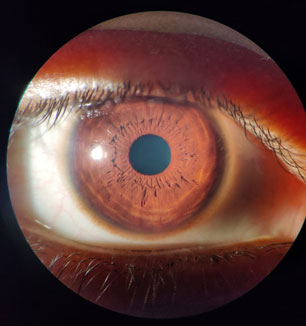
Anatomy of the Cornea
The cornea is composed of five layers:
Epithelium: The epithelium is the outermost layer of the cornea that keeps foreign objects out of the eye.
Bowman’s layer: This layer joins the stroma and the epithelium.
Stroma: The stroma is what gives the cornea its dome shape. It is the cornea’s thickest layer.
Descemet’s membrane: It is the thin layer that divides the endothelium and stroma.
Endothelium: This is a single layer of cells found between the stroma and the aqueous humor. The aqueous is a clear jelly-like substance found in our eye.
Recently a 6th layer called Dua’s layer has been discovered and added to the anatomical knowledge.
Similar to the glass covering on a watch dial, the cornea is clear and has a dome-like shape.
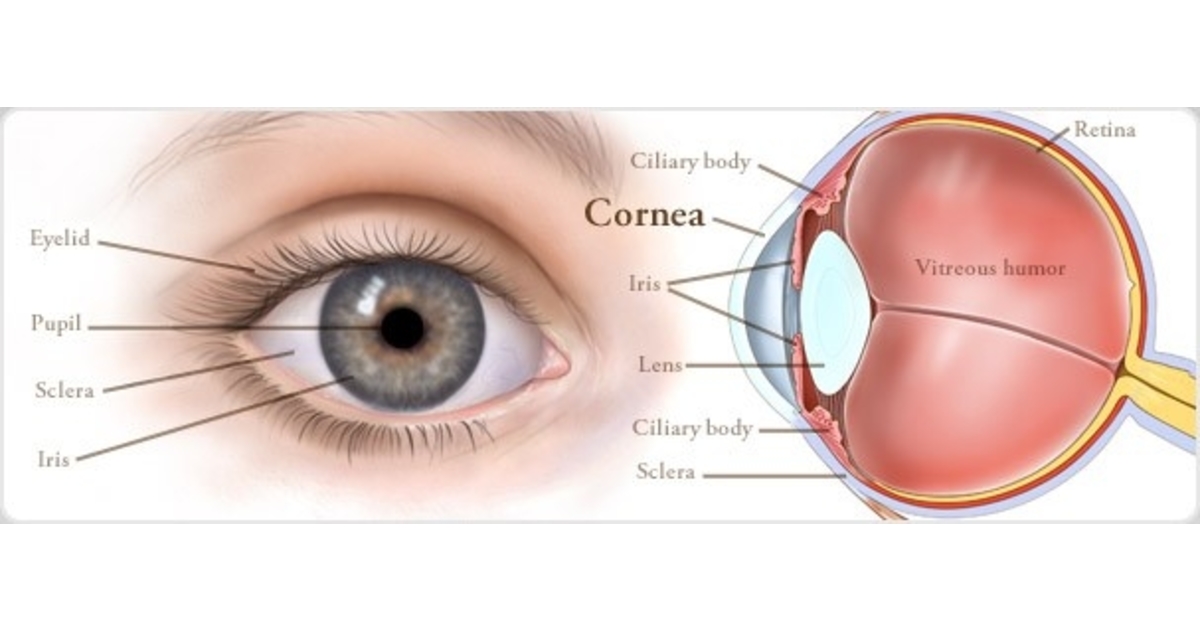
The cornea of eye Functions
the cornea functions like a camera lens, it helps to focus the light that comes into our eye onto the retina so that we have clear and sharp vision.
By acting as a shield, the cornea prevents objects from being stuck in or entering the inner eye.
How are cornea of eye problems diagnosed?
The Ophthalmologist does a thorough eye examination which includes the slit lamp examination, they can also do an fluorescein eye stain test to check for any scratches or damage visible to the cornea and a corneal topography scan can also be done to check for any surface abrasions or damage to the cornea.
Common Corneal Conditions:
1. Corneal infections
Commonly caused corneal ulcers/infections happen due to bacteria, virus, parasite.
Most common corneal ulcers/infections happen due to over use of contact lenses, or maybe even sleeping with contact lenses on, sometimes using homemade contact lens solutions.
Symptoms of corneal infections can include: blurry or hazy vision, eyes may appear red or bloodshot, discharge and itching, very painful eye and white patches on the cornea.
Treatment: on experiencing such symptoms the patient should immediately visit their ophthalmologist to prevent any further damage or scarring to the cornea and once a corneal infection is diagnosed, the doctor will treat it with antibiotics or whatever line of treatment is necessary.
Infections or immune reactions in the cornea are referred to as “Keratitis”. The term "CORNEAL ULCER" is frequently used to describe an infection that reaches deep enough to cause the intact layers of the cornea to break down.
These are usually accompanied by loss/reduction of transparency of the cornea, and hence the primary complaint of a patient presenting with central keratitis would be blurring of vision.
The healing process typically takes longer when there are infections. The right anti-infectives are administered orally or as drops to stop the infectious agent in its tracks.
Sometimes, keratitis, or infection of the cornea, heals with the creation of a scar that can lead to ongoing blurry vision. Depending on the amount of vision affected, extreme cases may even require a corneal transplant.
2. Corneal dystrophy and degeneration
These are relatively rare conditions involving the cornea of eye and may affect one or both eyes. Often they are idiopathic, meaning have no known cause. Even after surgery, they frequently result in visual deterioration and recurrence.
More than 20 different types of corneal dystrophies exist; most of them are hereditary and progress slowly over time.
The most common corneal dystrophies are:
Fuch’s dystrophy: the cornea swells up and gets very painful and the vision gets distorted.
Management/treatment: If the edoema does not improve with saline drops, soft contact lenses, or ointments, and the problem advances more quickly than anticipated, the patient will need to have a corneal transplant.
Granular dystrophy: this disorder results in lesions inside the eye that resemble granules or crumbs, which can become painful over time and impair vision.
Lattice dystrophy: in this condition the stroma gets covered with abnormal protein fibres, overtime they start to converge and take up more or most of the stroma hence affecting the cornea and causing cloudiness and affecting the vision.
Management/treatment: When the condition is severe enough, a corneal transplant can be performed to restore eyesight. Most patients with this illness have corneal scarring, which results in a persistent haze in vision that can get worse with time. A photothermerpeutic keratectomy, or PTK, is a laser-based procedure that may also be taken into consideration if scarring or hazing develops on the donor tissue following the transplant.
Map-dot fingerprint dystrophy: this disorder causes the epithelium to erode because it did not form normally, which alters the cornea's curvature and occasionally causes blurriness in vision.
management/treatment: In the early stages of this condition, eye drops or ointments can be used to treat it. To provide the patient with relief, additional procedures including corneal scraping and PTK can be performed.
3. Corneal Injuries
Corneal injuries can be classified broadly as traumatic and exposure related.
Traumatic injuries may include any damage to the surface due to any scratches or abrasions or any foreign body.(such as scratching your eye too hard, having a pencil or finger pushed in your eye unknowingly by mistake).
Burns caused by heat, chemicals, or radiation are examples of exposure-related injuries.
Rinse your eye with sterile, clean water, and then make sure the patient sees an ophthalmologist right once to prevent further damage to the eye.
Corneal Transplantation
When the cornea has suffered significant damage from an injury or when the preexisting corneal dystrophy has gotten worse, a corneal transplant may be necessary.
The damaged layer of the cornea is cut out in a circular pattern (like a cookie cutter) and replaced with healthy donor tissue during the transplant surgery.
It can take up to a year to fully recover from a corneal transplant. In one to two weeks, most people return to their regular habits and routine—except for heavy lifting. However, it is advised to wait at least four weeks before doing any heavy lifting, or longer if your doctor instructs it.
Cornea Care and Hygiene
Regular checkups with the Ophthalmologist- may require a Specular Microscopy
Put on some sunglasses to lessen the UV exposure from the sun.
Monitor your eye health and diabetes.
Cleaning your hands is a must before handling contact lenses.
use the CRD method while wearing contact lenses
C=cleanse; R=rinse; D=disinfect and dry with the right contact solution.
do not sleep with contact lenses on
Never clean your contact lenses with your saliva, tap water, or any other homemade nonsterile solution.
Lifestyle and Corneal Health
Consume a nutritious, well-balanced diet rich in vitamins, minerals, zinc, copper, and vitamin A, E, and C.
Put on sunglasses to shield your eyes from the UV radiation of the sun. get a good nights sleep
blinking the eyes at regular intervals is a good form of exercise for the eyes. moving the eyes up, down and sideways is also a good form of exercise for the eyes.
Visit our YouTube channel, "Dr Kareeshma Wadia- Jehan Eye Clinic," to watch our video on eye exercises.
Importance of corneal health and regular eye check-ups:
Dr Kareeshma Wadia has done a super speciality in this field and spent 2 years in Bangalore at Narayana Nethralaya Superspeciality Eye Hospital to master the art of these cornea transplant surgeries.
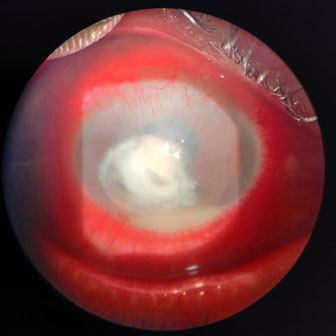
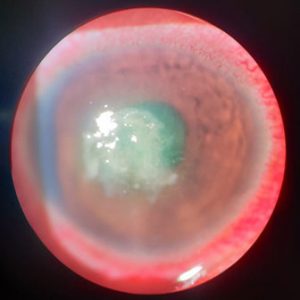
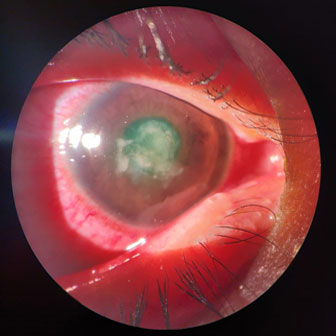
Specular Microscopy
Specular Microscopy is a non-invasive photographic technique that allows us to visualize and analyze the corneal endothelium. The endothelium is the inner most layer of the cornea, its main job is to provide good health and protection to the cornea.
This scan is done to check the number of endothelial cells present in a person’s cornea. Cornea is the transparent layer protecting the eye. The scan visualizes the cells of the innermost layer of the Cornea – called the Endothelium. This Endothelial cell count gets affected in conditions like Fuchs’ Dystrophy.
It helps the ophthalmologist to diagnose Fuchs’ Dystrophy or any other ocular conditions affecting endothelium. In this scan, modern microscopes analyze the shape, size, and quantity of endothelial cells.
In a healthy, normal cornea the endothelial cells are hexagon in shape and have a density of about 3000 cells, where as in a compromised or diseased cornea the cells are irregular in shape and the density is approximately below 1000.
Frequently Asked Questions
Jehan Eye Clinic is a center for skilled clinical excellence, and aims at being at par with the latest technology at all times. It is headed by Dr Kareeshma Wadia-Havewala, who is a specialist in Cataract, Cornea and Refractive Surgeries.
Quick Links
Contacts
- 302, D-Square, Dadabhai Road,Opp. C.N.M. School, Vile Parle West,Mumbai - 400056.
- +91 7045658586
- jehaneyeclinic@gmail.com
